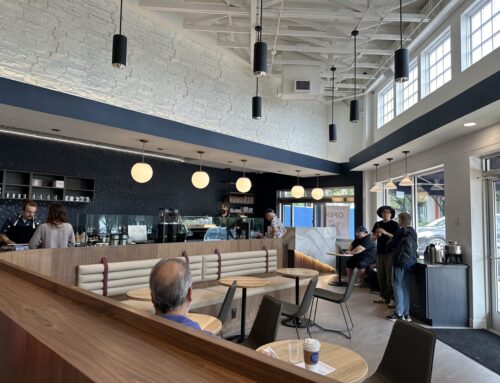Walk into Uptown’s Nick & Sam’s Steakhouse and order the 10-ounce filet mignon ($62) and fries ($14). Your total with tax and a 20% tip will leave you with a $98 tab.
Walk into Dakota’s Steakhouse and order the 8-ounce center-cut filet mignon ($57, the least expensive cut) and fries ($11 or $13 for the truffle fries). Your total with tax and a 20% tip will leave you with a $87 tab.
Walk into Northwest Highway’s Steakyard and order the 9-ounce tenderloin — the bistro cut to be exact — served with a brandy peppercorn sauce ($28). It comes with fries already, so your tab with tax and a 20% tip is $36.
In a city full of steaks, that’s a deal.
And it’s the point of the Steakyard.
Its focus is on steak frites, similar to the kind served at the French bistros owners Evandro Caregnato and Vanderleia Mallman frequent in Paris.
“We went to a fancy place. And then the next day we went to this bistro that cost like a fraction of the price and said, ‘Wow, we love this place. We love this place much more than the fancy one,’’’ Caregnato says. “So that’s what we want people to think when they come in here.”
The couple, originally from southern Brazil, came to the meteroplex after the founders of Texas de Brazil recruited Caregnato to help launch an authentic churrascaria in the late ’90s. After spending nearly two decades as their culinary director, his wife Mallman and him opened Delucca Gaucho, serving churrascaria-style pizza in Southlake before expanding to four more locations.
Meanwhile, they had already started working on building a restaurant on the property tucked behind REI and Starbucks. They weren’t sure if it was going to be another Delucca Gaucho or a different concept.
Then, out of left field, they got an offer they couldn’t refuse and sold Delucca Gaucho in 2022.
With a clean slate, they started fully devoting their time to the Steakyard. It was the perfect fit for their Northwest Highway property.
They sourced an assortment of secondhand tabletops, sanding them down in their Keller home. That’s why the tables are all different shapes and sizes. There are a few Restoration Hardware pieces scattered throughout the restaurant. A deep green, something between emerald and forest, coats the walls and juxtaposes the deep burgundy booths and the light wood.
“We want people to know that this is elegance, but approachable,” Caregnato says.
There’s not an extensive steak selection. There are three cuts — the bistro, the picanha and the ribeye — cooked over an open flame. The rest of the menu is simple. Six appetizers, including a rainbow ceviche, four alternative entrees, seven sides and four desserts.
“Whenever you have 100 different things on the menu, you need to have somebody in the back (who knows) how to make 100 different menu items,” Caregnato says. “So it’s better, we don’t have a lot of variety, but they know how to do it very well.”
The meat is aged 30 days before being served and the bistro is the best-selling item on the menu.
The cocktails are spins on classics. A lemon drop, but make it raspberry topped with a ball of fog. An old fashioned but use maple syrup instead for sugar cubes.
“We try to keep it simple. We do the popular drinks that people understand,” Mallman says.
The bartender and one of their managers came from Delucca. Their daughter Sophia, a business student at Southern Methodist University, works front of the house with Mallman. Their Cornell-bound son Lucas works in the kitchen alongside Caregnato.
“I feel like that’s my favorite part. To see them being us,” Mallman says.









